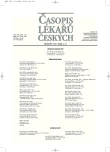Cefepime as an Empiric Treatment of Febrile Neutropenia in Patients after High Dose Therapy and Autologous Stem Cell Transplantation
Cefepim v empirické terapii febrilní neutropenie u pacientů léčených vysokodávkovanou chemoterapií s autologní transplantací krvetvorných buněk
Východisko.
Febrilní neutropenie je častou komplikací u intenzivně léčených hematoonkologických nemocných. Léčebným přístupem je aplikace širokospektrých antibiotik ať v monoterapii, nebo v kombinaci. Jednou z možností jsou cefalosporiny IV. generace. Cílem retrospektivní studie byla analýza efektivity a bezpečnosti empirické terapie cefepimem u pacientů ve febrilní neutropenii po vysokodávkované chemoterapii s autologní transplantací krvetvorných buněk.
Metody a výsledky.
Na I. interní klinice 1. LF UK a VFN bylo od ledna 2002 do prosince 2005 provedeno 319 vysokodávkovaných terapií s autologní transplantací krvetvorných buněk u 287 nemocných, nejčastější indikací byly hematologické malignity. Ve 229 (71,8 %) případech došlo k rozvoji febrilní neutropenie, z nichž 169 febrilních epizod u 163 pacientů s věkovým mediánem 53 let bylo iniciálně empiricky léčeno cefepimem v monoterapii. Dvanáct epizod (7,1 %) bylo dokumentováno klinicky (pneumonie 9, sinusitis 2, akutní cholecystitis 1), 60 (35,5 %) mikrobiologicky a 97 (57,4 %) bylo hodnoceno jako teplota nejasného původu. Z 60 mikrobiologicky dokumentovaných epizod (prezentováno jako bakterémie se záchytem v hemokultuře) dominovaly G+ mikroorganizmy (50 izolátů, 83,4 %), G- byly prokázány v 8 případech (13,3 %), ve 2 případech (3,3 %) byla zachycena smíšená G+ a G- flóra. Čtrnáct epizod (8,3 %) bylo dle MASCC skóre hodnoceno jako vysoce rizikových. Efekt monoterapie cefepimem byl zaznamenán v 85 případech (50,3 %), ve 22 (13,0 %) případech bylo dosaženo efektu terapií upravenou do kombinace z důvodu kultivačního záchytu v hemokultuře. Posílení antibiotické terapie do kombinace dvou přípravků (cefepim + glykopeptid nebo aminoglykosid) z důvodu perzistence febrilit bylo účinné u 13 (7,7 %) nemocných. Selhání léčby a nutnost kompletní změny antiinfekční terapie byla zaznamenána u 48 (28,4 %) epizod, 10 nemocných zemřelo.
Závěry.
Cefepim je vhodnou volbou v iniciální empirické léčbě febrilní neutropenie u hematologických nemocných. Je možné a často vhodné jej kombinovat s dalšími antimikrobiálními látkami (celkový efekt 71,0 %, v monoterapii 50,3 %).
Klíčová slova:
febrilní neutropenie, vysokodávkovaná terapie, transplantace, cefepim.
Authors:
E. Žikešová; M. Hnátková; B. Vacková; A. Jedličková 1; P. Klener; M. Trněný
Authors‘ workplace:
I. interní klinika 1. LF UK a VFN, Praha
; ÚKDBL Klinická mikrobiologie a ATB centrum VFN, Praha
1
Published in:
Čas. Lék. čes. 2006; 145: 383-389
Category:
Original Article
Overview
Background.
Febrile neutropenia is one of the most frequent complications in intensively treated hematooncological patients and almost inevitably occurs after high dose therapy and autologous stem cell transplantation. Empiric broad-spectrum antibiotic treatment is indicated in the initial management. Fourth-generation cephalosporins are the option. This retrospective study was initiated to assess efficacy and safety of cefepime as an empiric therapy of febrile neutropenia following high dose therapy and autologous stem cell transplantation.
Methods and Results.
319 high dose therapy procedures with autologous stem cell transplantation in 287 patients mostly with hematological malignancies were performed at our department between January 2002 and December 2005. We present analysis of 169 out of 229 febrile episodes in 163 patients (median age 53) being treated with cefepime in the initial empiric treatment of febrile neutropenia. 12 episodes (7.1 %) were clinically documented (pneumonia 9, sinusitis 2, acute cholecystitis 1), 60 (35.5 %) were confirmed microbiologically (presented as bacteremia) and 97 (57.4 %) were fever of unknown origin. 50 isolates (83.4 %) out of 60 microbiologically documented infections were G-positive bacteria, 8 isolates (13.3 %) were G-negative bacteria and 2 (3.3 %) were mixed G-positive and G-negative cultures. According to the MASCC score 14 episodes were assessed as high risk. Effect of cefepime as a single agent was observed in 85 episodes (50.3 %) and in 22 (13.0 %) episodes treated with combination therapy due to susceptibility of isolated pathogen in blood culture. Combination therapy of two antibiotics (cefepime + aminoglycoside or glycopeptide) given for persistent fever was effective in 13 patients (7.7 %). Treatment failure was observed in 48 (28.4 %) episodes, we registered 10 death.
Conclusions.
Therapy with cefepime represents an appropriate choice for empiric antibiotic treatment of febrile neutropenia in hematooncological patients. Cefepime demonstrates clinical safety and efficacy and can be used in monotherapy or in combination with other drugs (overall response 72.2 %, as a single agent 50.3 %).
Key words:
febrile neutropenia, high-dose therapy, transplantation, cefepime.
Labels
Addictology Allergology and clinical immunology Angiology Audiology Clinical biochemistry Dermatology & STDs Paediatric gastroenterology Paediatric surgery Paediatric cardiology Paediatric neurology Paediatric ENT Paediatric psychiatry Paediatric rheumatology Diabetology Pharmacy Vascular surgery Pain management Dental HygienistArticle was published in
Journal of Czech Physicians

- Metamizole vs. Tramadol in Postoperative Analgesia
- Metamizole at a Glance and in Practice – Effective Non-Opioid Analgesic for All Ages
- Advances in the Treatment of Myasthenia Gravis on the Horizon
- Current Insights into the Antispasmodic and Analgesic Effects of Metamizole on the Gastrointestinal Tract
- Spasmolytic Effect of Metamizole
Most read in this issue
- Buerger’s Disease
- Vascular Involvement in Thoracic Outlet Syndrome
- Superior Vena Cava Syndrome – Potential of the Intervention Therapy
- NGAL-Neutrophil Gelatinase Associated Lipocalin in Biochemistry, Physiology and Clinical Praxis
